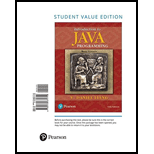
a)
“abstract” class:
An abstract class is a class which may or may not include abstract methods and cannot be instantiated but rather it can be sub classed.
Legal “abstract” class:
- The conditions for a class to be considered as legal abstract class are mentioned below:
- If a class includes abstract methods, then the class must be declared as abstract.
- The abstract method that is declared within the abstract class must be declared without braces and followed by a semicolon.
Example of a Legal “abstract” class:
The example of a legal abstract class is mentioned below:
public abstract class GraphicRectangle {
//declare fields
//declare methods
abstract void drawRectangle();
}
Given code:
//class definition
class A {
//declaration of an abstract method
abstract void unfinished() {
}
//end of class
}
b)
“abstract” class:
An abstract class is a class which may or may not include abstract methods and cannot be instantiated but rather can be sub classed.
Legal “abstract” class:
The conditions for a class to be considered as legal abstract class are mentioned below:
- If a class includes abstract methods, then the class must be declared as abstract.
- The abstract method that is declared within the abstract class must be declared without braces and followed by a semicolon.
Example of a Legal “abstract” class:
The example of a legal abstract class is mentioned below:
public abstract class GraphicRectangle {
//declare fields
//declare methods
abstract void drawRectangle();
}
Given code:
//class definition
public class abstract A {
//declaration of an abstract method
abstract void unfinished();
//end of class
}
c)
“abstract” class:
An abstract class is a class which may or may not include abstract methods and cannot be instantiated but rather can be sub classed.
Legal “abstract” class:
The conditions for a class to be considered as legal abstract class are mentioned below:
- If a class includes abstract methods, then the class must be declared as abstract.
- The abstract method that is declared within the abstract class must be declared without braces and followed by a semicolon.
Example of a Legal “abstract” class:
The example of a legal abstract class is mentioned below:
public abstract class GraphicRectangle {
//declare fields
//declare methods
abstract void drawRectangle();
}
Given code:
//class definition
class A {
//declaration of an abstract method
abstract void unfinished();
//end of class
}
d)
“abstract” class:
An abstract class is a class which may or may not include abstract methods and cannot be instantiated but rather can be sub classed.
Legal “abstract” class:
The conditions for a class to be considered as legal abstract class are mentioned below:
- If a class includes abstract methods, then the class must be declared as abstract.
- The abstract method that is declared within the abstract class must be declared without braces and followed by a semicolon.
Example of a Legal “abstract” class:
The example of a legal abstract class is mentioned below:
public abstract class GraphicRectangle {
//declare fields
//declare methods
abstract void drawRectangle();
}
Given code:
//class definition
abstract class A {
//declaration of a protected method
protected void unfinished();
//end of class
}
e)
“abstract” class:
An abstract class is a class which may or may not include abstract methods and cannot be instantiated but rather can be sub classed.
Legal “abstract” class:
The conditions for a class to be considered as legal abstract class are mentioned below:
- If a class includes abstract methods, then the class must be declared as abstract.
- The abstract method that is declared within the abstract class must be declared without braces and followed by a semicolon.
Example of a Legal “abstract” class:
The example of a legal abstract class is mentioned below:
public abstract class GraphicRectangle {
//declare fields
//declare methods
abstract void drawRectangle();
}
Given code:
//class definition
abstract class A {
//declaration of an abstract method
abstract void unfinished();
//end of class
}
f)
“abstract” class:
An abstract class is a class which may or may not include abstract methods and cannot be instantiated but rather can be sub classed.
Legal “abstract” class:
The conditions for a class to be considered as legal abstract class are mentioned below:
- If a class includes abstract methods, then the class must be declared as abstract.
- The abstract method that is declared within the abstract class must be declared without braces and followed by a semicolon.
Example of a Legal “abstract” class:
The example of a legal abstract class is mentioned below:
public abstract class GraphicRectangle {
//declare fields
//declare methods
abstract void drawRectangle();
}
Given code:
//class definition
abstract class A {
//declaration of an abstract method
abstract int unfinished();
//end of class
}
Trending nowThis is a popular solution!

Chapter 13 Solutions
Introduction to Java Programming and Data Structures: Brief Version (11th Global Edition)